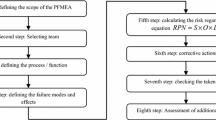Abstract
During recent years, six sigma has been used as effective tool in quality management system in various industries in order to reduce wastes. Design for six sigma (DFSS) is one of the six sigma methodologies. It is a complex and powerful mechanism that can help us to increase success for new technology or product. In this research, we develop a framework to evaluate the quality of EF7oil filter, using Identify—Characterize—Optimize—Validate (ICOV) approach; one of the DFSS methods. In first phase, we should ensure that none of the customer needs have not ignored. For this purpose, we identified all customer needs and then prioritized them using analytical network process method, after that, we prepared a list of technical requirements to meet mentioned needs. At the second phase, we prioritized failure causes of a filter using six sigma tools such as cause and effect diagram, Failure mode and effect and House of quality. Then choose the most important failure causes for action improve practices to achieve the appropriate sigma level. We understood that the most important needs of costumer is “no tear or hole in filter paper” and also the lack of structure in this filter is the main factor of oil filter failure which causes to decrease the sigma level to 4.83. Finally by prioritizing the technical requirements, determined that the designing an interior structure with the importance of 3.02 is the most important of design requirement that doing necessary changes can improve significantly the sigma level. Gathering all of these phases in one structured framework, “ICOV”, leads to develop the appropriate infrastructure which is used by various industries including automotive industry. It reduces the confusion in using the large number of quality techniques and tools in order to take effective preventive and corrective actions in production processes, instead of just doing final inspection and achieving customer satisfaction.




Similar content being viewed by others
References
Douglas PM (2002) Design for six sigma frontier of quality, quality progress, the official publication of ASQ. www.ASQ.ORG
Ericsson E, Lilliesköld J, (2012) Identifying weaknesses in the design for six sigma concept through a pedagogical structure. In: Proceedings of PICMET’12: technology management for emerging technologies. pp 3379–3386
Ericsson E, Gustafsson P, Lilliesköld J, Sörqvist L (2009) DFSS—evolution or revolution? a study of critical effects related to successful implementation of DFSS. In: Proceedings of 12th ICQSS conference
Evelina Ericsson, Gingnell Liv, Lilliesköld Joakim (2015) Implementing design for six sigma in large Swedish product developing organizations—an interview study. Total Qual Manag Bus Excell 26:5–6
Gijo EV, Johny Scaria (2010) Redacting rejection and rework by application of six sigma methodology in manufacturing process. Int J Six Sigma Compet Advant 6(1–2):77–90
Henderson K, Evans J (2000) Successful implementation of six sigma: benchmarking general electric company. Benchmarking Int J 7(4):260–281
Koziołek S, Derlukiewicz D (2012) Method of assessing the quality of the design process of construction equipment with the use of DFSS (design for six sigma). Autom Constr 22:223–232
Kwak YH, Anbari FT (2006) Benefits, obstacles, and future of six sigma approach. Technovation 26(5):708–715
Mitchell EM, Kovach V (2016) Improving supply chain information sharing using design for six sigma. Eur Res Manag Bus Econ 22(3):147–154
Paiva AP, Campos PH, Ferreira JR, Lopes LG, Paiva EJ, Balestrassi PP (2012) A multivariate robust parameter design approach for optimization of AISI 52100 hardened steel turning with wiper mixed ceramic tool. Int J Refract Metals Hard Mater 30(1):152–163
Pugna A, Negrea R, Miclea S (2016) Using six sigma methodology to improve the assembly process in an automotive company. Procedia Social Behav Sci 221:308–316
Pyle MJ, Liker JK (2014) Imitation in large complex organizations: a case of design for six sigma in the automobile industry. J Enterp Transform 4(2):76–99
Shahin A (2008) Design for six sigma (DFSS): lesson learned from world-class companies. Int J Six Sigma Compet Advant 4(1):48–59
Srinivasan K, Muthu S, Devadasan SR, Sugumaran C (2014) Enhancing effectiveness of shell and tube heat exchanger through six sigma DMAIC phases. Procedia Eng 97:2064–2071
Wang F-K, Yeh C-T, Chu T-P (2016) Using the design for six sigma approach with TRIZ for new product development. Comput Ind Eng 98:522–530
Acknowledgments
The authors would like to appreciate the management and also the staff of manufacturer’s evaluation office in engineering and quality management department of ISACO in order to support and provide information and also Islamic Azad University South Tehran Branch.
Author information
Authors and Affiliations
Corresponding author
Rights and permissions
About this article
Cite this article
Shojaie, A.A., Kahedi, E. Auto parts manufacturing quality assessment using design for six sigma (DFSS), case study in ISACO company. Int J Syst Assur Eng Manag 10, 35–43 (2019). https://doi.org/10.1007/s13198-018-0745-6
Received:
Revised:
Published:
Issue Date:
DOI: https://doi.org/10.1007/s13198-018-0745-6




